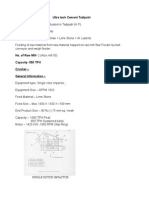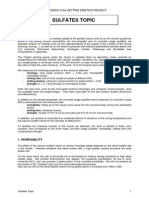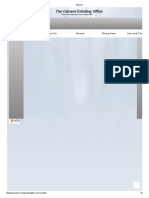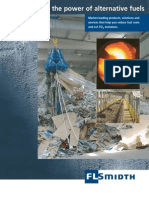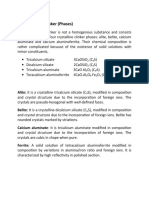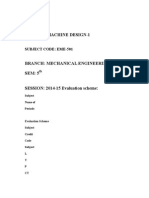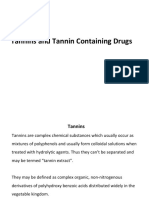C Clliinnkkeerr:: Rreeaaccttiioonnss Iinn Tthhee Kkiillnn
Uploaded by
Familoni LayoC Clliinnkkeerr:: Rreeaaccttiioonnss Iinn Tthhee Kkiillnn
Uploaded by
Familoni LayoHome
Article Directory
Cement Blog
Training
General
Cement
Cl i nker : r eact i ons i n t he ki l n
This page reviews the reactions which take place as the feed passes through the
The blended, milled raw materials go to a silo and from there to the kiln.
The reactions which take place in the kiln can be considered under three broad
headings:
Decomposition of raw materials - reactions at temperatures up to about 13
Alite formation and other reactions at 1300 C-1450 C in the burning zone.
Cooling of the clinker.
Decomposition of raw
w m a t e r i a l s - r e a c t i o n ss a t t e m p e r a t u r e s u p t
about 1300 C
This includes:
i.
ii.
iii.
iv.
Water evaporation in the raw feed, if any.
Loss of carbon dioxide from the limestone (ie: calcining).
Decomposition of the siliceous and aluminosilicate fractions of the feed.
Formation of a sulfate melt phase.
The decomposition products react with lime to form intermediate compounds whi
turn form other compounds as clinkering proceeds.
Wa t e r e v a p o r a t i o n
In wet-process kilns, and their derivatives, water must first be driven off. In a
wet-process kiln, calcining takes place after the water has been driven off, about
third of the way down the kiln. In the more modern pre-calciner kilns, the feed is
calcined prior to entering the kiln.
Cal ci ni ng
In isolation, decarbonation of calcium carbonate at 1 atmosphere takes place at 8
This temperature is reduced to 500 C-600 C if the reaction takes place in contact
quartz or the decomposition products of clay minerals, which react with the calciu
oxide as it forms.
In a wet-process or preheater system without a pre-calciner, most of the calcinat
takes place in the rotary kiln within a moving mass of feed. This situation is not id
for calcination because heat transfer has to take place through a large mass of m
and CO2 has to escape outwards as heat moves inwards.
A pre-calciner calcines the raw material much more efficiently than a wet-process
Raw meal is dispersed in the hot gas and calcination takes place in seconds, rathe
than the half an hour or so inside a kiln at the same temperature.
F o r ma t i o n o f e a r l y a n
nd
d i n t e r me d i a t e c o mp o u n d s
During calcination, the lime produced starts to react with other components of th
feed. The initial silicate product is belite. Some calcium aluminate and ferrite pha
also start to form.
A number of phases are formed in the clinker feed before the burning zone prope
reached. These intermediate phases dissociate in the burning zone and are not
therefore found in clinker but assist in forming the final clinker minerals.
S u l f a t e me l t p h a s e
At intermediate temperatures, sulfates combined with calcium and alkalis form a
phase. This is separate from the aluminate and aluminoferrite-based liquid forme
the burning zone - the two liquids are immiscible.
As with the main liquid phase, the sulfate liquid phase contributes to ion mobility
promotes combination.
A l i t e f o r m a t i o n a n d o tth
he r r e a c t i o n s a t
1 3 0 0 C - 1 4 5 0 C i n t h ee b u r n i n g z o n e
In the burning zone, above about 1300 C, reactions take place quickly. The clinke
the burning zone for perhaps 10-20 minutes but in this time a lot happens:
i.
ii.
iii.
iv.
The proportion of clinker liquid increases and nodules form.
Intermediate phases dissociate to form liquid and belite.
Belite reacts with free lime to form alite.
Some volatile phases evaporate.
Cl i nker l i qui d and nod
du
ul e f or mat i on
Above about 1300 C the proportion of liquid starts to increase - by 1450 C, perha
20-30% of the mix is liquid. The liquid forms from melting ferrite and aluminate p
and some belite. The liquid content is more than the sum of the aluminate and fe
phases in the cooled clinker because of the dissolved lime and silica.
The additional liquid causes coalescence of clinker particles, leading to the format
nodules.
Di ssoci at i on of i nt er m
meedi at e phases
The intermediate phases dissociate to form mainly aluminate phase, which then
becomes part of the liquid, and belite.
A l i t e f o r ma t i o n
Alite forms by the transition of some of the belite to alite and also directly from f
lime and silica to alite. These reactions occur rapidly once the clinker temperature
above about 1400 C.
Evaporat i on of vol at i llees
Volatile phases in the cement kiln are principally alkali sulfates, with a much sma
proportion of alkali chlorides. As the part-burned feed approaches the burning zo
these volatile phases are in liquid form and a proportion volatilizes, the remainde
passing out of the kiln in the clinker as inclusions within the pores.
The volatilized material passes back down the kiln, where it condenses on the rel
cool incoming feed. It again becomes part of the sulfate melt phase, promoting
reactions, and is once again carried within the clinker towards the burning zone.
This recirculating load of alkali and sulfate can occasionally become excessively h
Large quantities of condensing volatiles can then cause blockages in the kiln or in
preheater as the condensed liquid sticks feed particles together, forming accretio
Cooling of the clinker
As the clinker cools, the main liquid phase crystallizes to form aluminate phase, f
and a little belite.
Fast cooling of clinker is advantageous - it makes for more hydraulically-reactive
silicates and lots of small, intergrown, aluminate and ferrite crystals.
Slow cooling gives less hydraulically-reactive silicates and produces coarse crysta
aluminate and ferrite - over-large aluminate crystals can lead to erratic cement s
characteristics. Very slow cooling allows alite to decompose to belite and free lim
You are in Cl i nker : r eact i ons i n t he ki l n
The following pages have more details on clinker composition, reactions in the kil
cement milling:
Cement notation / Clinker compositional parameters / Bogue calculation /
Combinability / Cement milling
Check the Ar t i cl e Di r ect ory for more more articles on this or related
Share thi s page:
What's This?
N
Neew
wsslleetttteerr
U
Un
nd
deerrssttaan
nd
diin
ng
gC
Ceem
meen
ntt:: tth
hee
You might also like
- Bowmanville Cement Technology - Kiln SystemsNo ratings yetBowmanville Cement Technology - Kiln Systems16 pages
- Cement Manufacturing Using Alternative Fuels and The Advantages of Process ModellingNo ratings yetCement Manufacturing Using Alternative Fuels and The Advantages of Process Modelling6 pages
- Industrial Waste As Alternative Fuel in Cement Industry: Its Impact On EnvironmentNo ratings yetIndustrial Waste As Alternative Fuel in Cement Industry: Its Impact On Environment7 pages
- Sulfates Topic: Synthesis of The Setting Kinetics ProjectNo ratings yetSulfates Topic: Synthesis of The Setting Kinetics Project10 pages
- Slide 1 - 25.01.2007: HR Activities & Outlook 2007 - Sid TuliNo ratings yetSlide 1 - 25.01.2007: HR Activities & Outlook 2007 - Sid Tuli33 pages
- P-02-0098-DCVL-Refractory SpecificationNo ratings yetP-02-0098-DCVL-Refractory Specification26 pages
- Portland Cement: Wednesday, March 25, 2015No ratings yetPortland Cement: Wednesday, March 25, 201535 pages
- The Use of Coal As Fuel For Cement Rotary KilnNo ratings yetThe Use of Coal As Fuel For Cement Rotary Kiln23 pages
- The Cement Grinding Office: Home About Us Services Mining Area Links and ContactNo ratings yetThe Cement Grinding Office: Home About Us Services Mining Area Links and Contact2 pages
- AlternativeFuel - Ashx Foir Cement PlantNo ratings yetAlternativeFuel - Ashx Foir Cement Plant4 pages
- Usage of Cement Kiln Dust in Cement Products - Research ReviewNo ratings yetUsage of Cement Kiln Dust in Cement Products - Research Review7 pages
- Alternative Raw Materials and Composite Cement Strategies - Hans-Wilhelm MeyerNo ratings yetAlternative Raw Materials and Composite Cement Strategies - Hans-Wilhelm Meyer10 pages
- 4 - Pilot Scale Manufacture of LC3-Indian ExperienceNo ratings yet4 - Pilot Scale Manufacture of LC3-Indian Experience7 pages
- 1 Basic Knowledge of Cement Production Technics - Ó+ Ñêi+ Í - ÂNo ratings yet1 Basic Knowledge of Cement Production Technics - Ó+ Ñêi+ Í - Â19 pages
- Cement Kiln Process Chemistry: Module 2. Cement Clinker Quality and CompositionNo ratings yetCement Kiln Process Chemistry: Module 2. Cement Clinker Quality and Composition2 pages
- Petcoke in Cement Industry - Global Cement Conference - MumbaiNo ratings yetPetcoke in Cement Industry - Global Cement Conference - Mumbai28 pages
- Modeling Identification and Control Od Cement KilnNo ratings yetModeling Identification and Control Od Cement Kiln1 page
- Clinker Formation and Clinker Granulometry PDFNo ratings yetClinker Formation and Clinker Granulometry PDF120 pages
- Chapter 3-Chemistry and Physics of Clinker Burnin-DrusbaNo ratings yetChapter 3-Chemistry and Physics of Clinker Burnin-Drusba50 pages
- 12 Rudowski - tk_polysius_240202_101210No ratings yet12 Rudowski - tk_polysius_240202_10121038 pages
- Summary of 2017 Principal Academic Dates For Australian Universities For Updates To This Data Visit WWW - Universitiesaustralia.edu - AuNo ratings yetSummary of 2017 Principal Academic Dates For Australian Universities For Updates To This Data Visit WWW - Universitiesaustralia.edu - Au1 page
- The Netherlands Code of Conduct For Academic Practice 2004 (Version 2014)No ratings yetThe Netherlands Code of Conduct For Academic Practice 2004 (Version 2014)11 pages
- Supporting Information High Energy Output Nanogenerator Based On Reduced Graphene OxideNo ratings yetSupporting Information High Energy Output Nanogenerator Based On Reduced Graphene Oxide5 pages
- Supplementary Figure 1 - Preparation Process of Long Hydras. (A) A Polyimide Tape Served AsNo ratings yetSupplementary Figure 1 - Preparation Process of Long Hydras. (A) A Polyimide Tape Served As6 pages
- Energy Harvesting From Humidity Changes With A Flexible CoaxialNo ratings yetEnergy Harvesting From Humidity Changes With A Flexible Coaxial6 pages
- Synthesis of Visible-Light Responsive Graphene Oxide-TiO2 Composites With P-N HeterojunctionNo ratings yetSynthesis of Visible-Light Responsive Graphene Oxide-TiO2 Composites With P-N Heterojunction8 pages
- Room-Temperature Humidity Sensing Using Graphene Oxide Thin FilmsNo ratings yetRoom-Temperature Humidity Sensing Using Graphene Oxide Thin Films13 pages
- SR Elite, Aiims S60, MPL & LTC Aits Grand Test - 21 Paper Key (02-05-2023)No ratings yetSR Elite, Aiims S60, MPL & LTC Aits Grand Test - 21 Paper Key (02-05-2023)8 pages
- Aceite Mineral 60 USP - Ficha Tecnica - Lubline - Ingles PDFNo ratings yetAceite Mineral 60 USP - Ficha Tecnica - Lubline - Ingles PDF1 page
- Miss - Sharmin S. Saudagar Miss - Gouri D.Patkale Govt. College of Engg. KaradNo ratings yetMiss - Sharmin S. Saudagar Miss - Gouri D.Patkale Govt. College of Engg. Karad13 pages
- Rat PDGF (Platelet-Derived Growth Factor) ELISA Kit: Instruction ManualNo ratings yetRat PDGF (Platelet-Derived Growth Factor) ELISA Kit: Instruction Manual9 pages
- Synolac 162 W 70: Product Application DetailsNo ratings yetSynolac 162 W 70: Product Application Details2 pages
- The Conversion of Biomass To Fuels Via Cuttingedge TechnologiesNo ratings yetThe Conversion of Biomass To Fuels Via Cuttingedge Technologies13 pages
- Solutions Manual for Physical Chemistry Seventh Edition Peter Atkins - Quickly access the ebook and start reading today100% (2)Solutions Manual for Physical Chemistry Seventh Edition Peter Atkins - Quickly access the ebook and start reading today53 pages
- Cost-Effectiveness of Solar Water ProductionNo ratings yetCost-Effectiveness of Solar Water Production11 pages
- 5-1-exothermic-and-endothermic-reactions-99VmQxp6BMx478nZNo ratings yet5-1-exothermic-and-endothermic-reactions-99VmQxp6BMx478nZ13 pages
- CHE GE SEM 2 SYLLABUS Pdf by VBU & JAC UPDATESNo ratings yetCHE GE SEM 2 SYLLABUS Pdf by VBU & JAC UPDATES3 pages
- The Simulated Moving Bed Chemical Reactor: (Received 9 May Acceptedfor Publication 5 October 1994) Abstrati-ANo ratings yetThe Simulated Moving Bed Chemical Reactor: (Received 9 May Acceptedfor Publication 5 October 1994) Abstrati-A8 pages
- Electromagnetic Induction (Chapter 23) :: 1 - Physics (A-Level)No ratings yetElectromagnetic Induction (Chapter 23) :: 1 - Physics (A-Level)11 pages
- Preparation of A Synthetic Plant HormoneNo ratings yetPreparation of A Synthetic Plant Hormone2 pages














